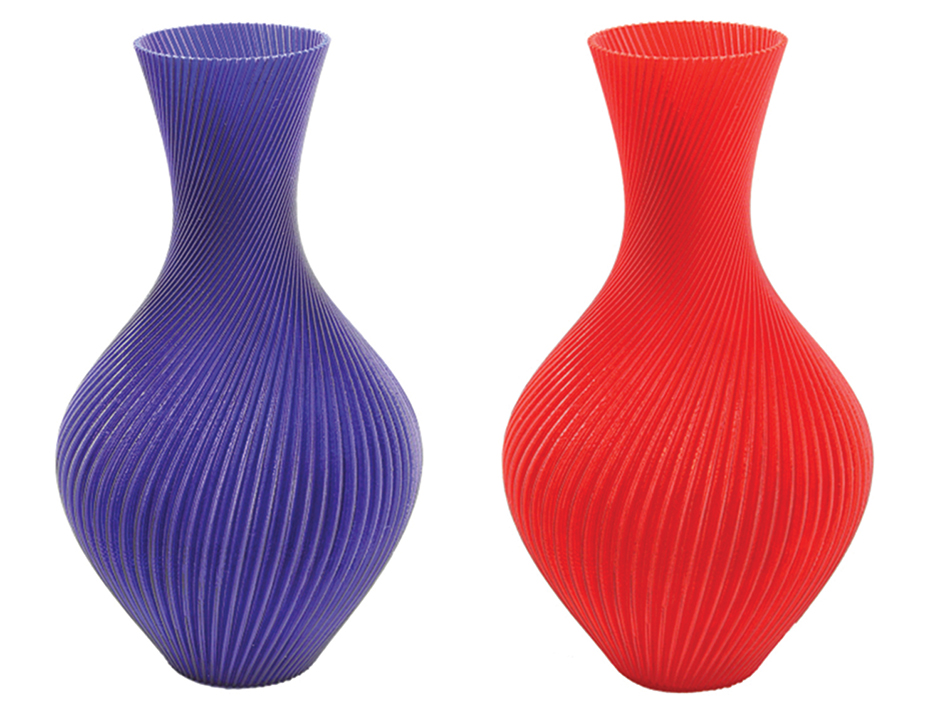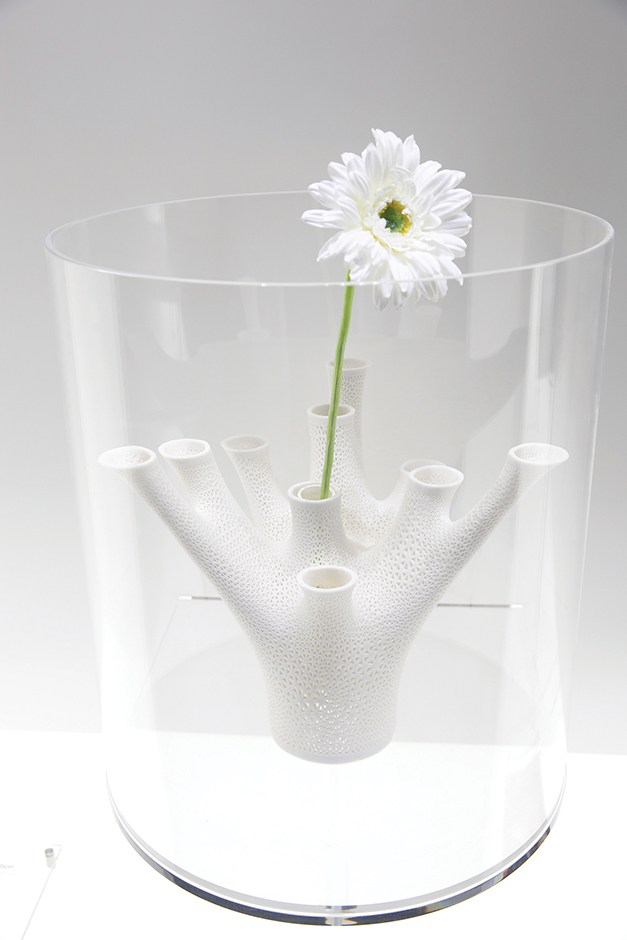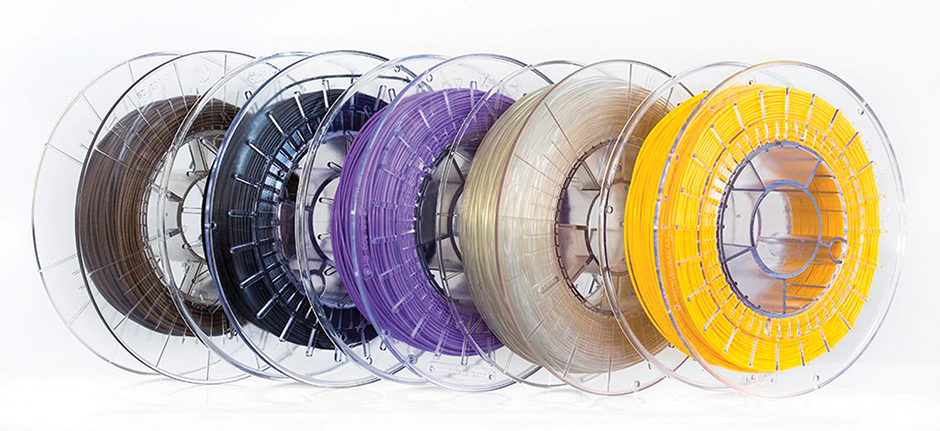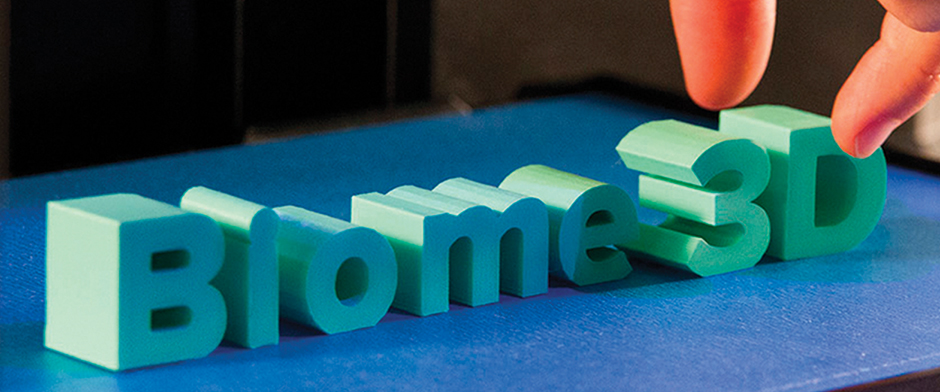3D Printing Makes Material Advances
Companies are stepping up their efforts to expand the limited palette of resins suitable for additive manufacturing
Previous Article Next Article
By Jon Evans
3D Printing Makes Material Advances
Companies are stepping up their efforts to expand the limited palette of resins suitable for additive manufacturing
Previous Article Next Article
By Jon Evans
3D Printing Makes Material Advances
Companies are stepping up their efforts to expand the limited palette of resins suitable for additive manufacturing
Previous Article Next Article
By Jon Evans

3D Vases. Courtesy of Covestro LLC.

3D Vases. Courtesy of Covestro LLC.

Covestro offers TPU filaments made from some of its existing grades. Image courtesy of Covestro LLC. LLC.

Royal DSM has launched new filaments for FDM which possess superior properties to ABS and PLA. Image courtesy of Royal DSM.

Royal DSM has launched new filaments for FDM which possess superior properties to ABS and PLA. Image courtesy of Royal DSM.

Biome Bioplastic has developed a thermoplastic starch material that combines superior finish and flexibility. Courtesy of Biome Bioplastic.

Biome Bioplastic has developed a thermoplastic starch material that combines superior finish and flexibility. Courtesy of Biome Bioplastic.
Three-dimensional printing, also known as additive manufacturing, already has amply demonstrated its potential. By building up a computer-generated design layer-by-layer, 3D printing offers the ability to produce objects more efficiently and cheaply than conventional subtractive manufacturing techniques, producing much less waste.
What is more, it also can tailor objects for specific uses, such as shoes designed for the precise shape of a person’s feet, and create objects with intricate designs that simply couldn’t be produced with conventional techniques. As such, 3D printing already has been embraced by individual hobbyists, a whole host of academic fields and industries such as aerospace, automotive and medical.
What 3D printing doesn’t yet offer, though, is the ability to work with lots of different materials, especially plastic materials. German materials company Covestro LLC (formerly Bayer MaterialScience) says that only about 30 materials are currently available for 3D printing, compared with more than 3,000 materials available for conventional manufacturing. This comparative lack of materials obviously constrains the kinds of objects that can be produced with 3D printing and the types of applications for which it can be used. Thus, even though the 3D printing sector is expanding rapidly, experiencing growth of some 30% a year, it is still being held back by the limited range of materials available for it.
Fortunately, this range is becoming less limited all the time. Chemical companies and 3D printing companies alike, often in conjunction with one another, are actively developing and releasing new plastic materials with various different properties to meet the growing demands being placed on 3D printing. The fruits of some of these efforts have been appearing over the past few months.
Adding both complexity and opportunity to the development of new materials for 3D printing is the fact that there are several different techniques to consider. The current most popular 3D printing technique is fused deposition modelling (FDM), also known as fused filament fabrication. As its name suggests, this technique melts a thin plastic filament and then extrudes it through a nozzle as a thin fiber to form layers in a desired pattern, with each layer hardening as it cools and merging with another layer added on top.
FDM is particularly popular with hobbyists, as it is the cheapest form of 3D printing, with printers available for just a couple of thousand dollars, although it is also commonly used by academia and industry as well. It theoretically can be used with any thermoplastic, but the two most popular are currently acrylonitrile butadiene styrene (ABS) and the bioplastic polylactic acid (PLA). ABS is stronger and more flexible and can withstand higher temperatures, while PLA is more sustainable and produces an attractive candy-like smell during printing. Other thermoplastics currently available as filaments for FDM include polyamide (nylon), polyethylene terephthalate (PET), polycarbonate (PC), thermoplastic elastomers (TPE) and thermoplastic polyurethane (TPU).
The main limitation of FDM is that its resolution has tended to be fairly low, with the size of the features it could print depending on the diameter of the fiber extruded by the nozzle. However, this resolution is steadily improving, such that a team of U.S. researchers was recently able to print a microfluidic device in ABS with channels just 130μm wide and 30μm deep (Analytical Chemistry, 2016, 88, 7675−7682).
Even greater resolution can be achieved with selective laser sintering (SLS), in which a plastic powder is deposited in layers and then fused together in a defined pattern by scanning it with a laser. Like FDM, SLS theoretically can work with any thermoplastic, as well as metal and ceramic powders, although polyamide and TPU are the most widely used plastic materials. Another advantage that SLS has over FDM is that it doesn’t require the fabrication of temporary sections for supporting overhanging layers, as they can be supported by the powder, making it easier to produce very complex structures.
The 3D printing technique with the highest resolution, down to around 100nm, is also the oldest, first developed in the 1980s. Known as stereolithography, it involves fabricating solid objects out of a vat containing a liquid photocurable polymer. This is done by allowing a layer of the solution to wash over the top or bottom of the growing object and then polymerizing this layer by scanning it with an ultraviolet (UV) laser in a defined pattern. Because of its high resolution and cost, and the fact that it can only work with specially developed, photocurable polymers, stereolithography is mainly used for industrial applications.
Although both FDM and SLS theoretically can work with any thermoplastics, it sometimes has proven quite challenging to develop grades that work effectively with these 3D printing techniques. In particular, the kinds of high-performance polymers with the enhanced strength and heat tolerance required by industry are often difficult to melt and then extrude through the nozzles of FDM printers.
For some chemical companies, though, it’s not so much a question of developing new grades of thermoplastics for FDM but more of discovering which of their many existing grades are most suitable for FDM. Covestro, for example, offers TPU and PC filaments made from some of its existing grades. The company claims that its TPU, particularly its Desmopan range, is well suited to FDM because of its excellent abrasion resistance and elasticity, and that its PC grades offer the temperature stability and toughness required for 3D printing.
Nevertheless, Covestro also is actively developing new plastic materials with enhanced properties for FDM. To this end, it recently opened a new laboratory for 3D printing at its headquarters in Leverkusen, Germany. Other chemical companies are already launching such materials. In April 2016, Dutch chemical company Royal DSM launched two new plastic filaments for FDM, which it claims possess superior properties to ABS and PLA. These are: a highly flexible thermoplastic copolyester called Arnitel ID, which according to DSM exhibits no buckling and offers a higher print speed than existing thermoplastic elastomers; and a polyamide called Novamid ID, which DSM says is very ductile and can withstand harsh environments and high temperatures of up to 150°C.
The Belgian chemical company Solvay, meanwhile, in conjunction with the U.S. 3D printing start-up Arevo Labs, has found a way to produce filaments for FDM made from various high-performance polymers. These include polyphenylsulfone (PPSU), polyetheretherketone (PEEK) and polyaryletherketone (PAEK). Owing to the inherent difficulties of printing these polymers, this required Solvay to develop novel formulations and Arevo to develop an innovative extrusion technology for use with FDM printers. To enhance their strength and toughness still further, Solvay and Arevo also have developed a way to incorporate carbon fiber and carbon nanotubes into these filaments.
The popularity of PLA filaments means that bioplastic producers are getting in on the act, as well, developing both PLA filaments with enhanced properties and alternatives to PLA. In March 2016, the U.S. company NatureWorks LLC launched a new formulation of PLA designed specifically for 3D printing. With enhanced impact and heat resistance, this formulation is intended to compete with ABS. The British company Biome Bioplastics has developed a novel thermoplastic starch material for FDM, which Biome says combines superior finish and flexibility with ease of processing and excellent print details, allowing it to be run at higher print speeds than PLA.
Many of these same chemical companies have also formulated their plastic materials as powders for use with SLS. Covestro offers TPU powders, while Solvay offers various grades of polyamide powders and is due to launch several new grades at the K 2016 show in October. German chemical giant BASF recently launched a new polyamide powder for SLS, which it claims can produce objects with higher strength and heat stability than possible with other polyamide powders.
The range of materials available for stereolithography also is expanding. DSM currently offers the greatest range under its Somos brand, including flexible materials, transparent materials and materials that look and feel just like thermoplastics, although companies such as Covestro also are beginning to get involved.
Most recently, DSM launched Somos Element, a stereo-lithography material for investment casting, which is a way to create ceramic molds using disposable patterns that are burnt away after use. These patterns have conventionally been made from wax, but Somos Element will allow more complex patterns to be produced by stereolithography. According to DSM, Somos Element burns out efficiently with a minimal amount of ash residue, which can easily be removed.
Sometimes, though, expanding the range of materials that work with 3D printing involves developing an entirely new kind of 3D printing. This is the case with silicones, which aren’t thermoplastics and therefore won’t work with FDM or SLS, but have a wide range of applications that could benefit from 3D printing, especially medical applications. So German chemical company Wacker Chemie AG set about developing a novel 3D printing technique that would work with silicones.
The technique it came up with involves depositing individual droplets of a silicone solution in a desired pattern. These droplets are allowed to merge with each other into a line and then vulcanized by illuminating them with UV light to form the characteristic rubbery material. Wacker will be unveiling a printer that uses this technique, called ACEO Imagine Series K, at the upcoming K 2016 in Düsseldorf, Germany.
With so many new materials becoming available, the potential of 3D printing continues to hold great promise.